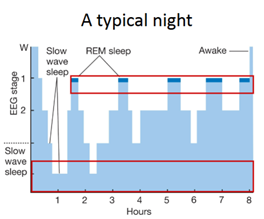Brain and Behaviour (9): Sleep & Circadian Rhythms
1/29
There's no tags or description
Looks like no tags are added yet.
Name | Mastery | Learn | Test | Matching | Spaced |
|---|
No study sessions yet.
30 Terms
Sleep
A natural periodic state with reduced responsiveness to stimuli and decreased mobility, occurring in all animals and even unicellular organisms.
What are the two main drives of sleep?
Homeostatic (sleep debt)
Circadian (time-of-day regulation)
Polysomnography (PSG)
The gold standard of sleep measurement involving multiple recordings like EEG, EOG, EMG, heart rate, etc, which reveals sleep structure.
What recordings comprise PSG?
EEG: Records neuronal activity just beneath the skull.
EOG: Records eye muscle activity to decipher eye movement
EMG: Records body muscle activity
What are the different waves observed in EEG recordings?
Beta waves (13-30hz): Takes place when the brain is processing information. The person is alert.
Alpha waves (8-12hz): Occur when a person is resting quietly
Theta waves (3.5–7.5 Hz)
delta waves (< 3.5 Hz)
Stages of Sleep
Stage 1: Theta waves (3.5–7.5 Hz), light sleep, transition from wakefulness.
Stage 2: Onset of true sleep; sleep spindles (12–14 Hz) and K-complexes.
Stage 3: Slow-wave sleep with delta waves (< 3.5 Hz), deep sleep, synchronized brain activity, reduced bodily functions.
REM: Rapid eye movement, brain wave asynchrony, muscle atonia, vivid dreaming, paradoxical sleep (active brain, relaxed body).
How long is a typical sleep cycle?
90 minutes

Who discovered Dreams?
Dement and Kleitman (1957): When participants were awakened from REM sleep they reported vivid dreams
What did Calvin Hall et al. find about dream content?
64% negative emotions
18% happy
1% sexual
What is the Activation-Synthesis Hypothesis?
Suggests dreams are meaningless brain activity from the brainstem during REM, interpreted by the cortex. (Allan Hobson, 2004)
How is sleep chemically induced?
Natural substances (e.g. morphine)
Neurochemicals and hormones can produce sleep wake cycles
What does adenosine do?
Builds during wakefulness and promotes sleep. Effect blocked by caffeine.
What brain area promotes sleep via GABA?
vlPOA (ventrolateral preoptic area) in anterior hypothalamus. Damage → Insomnia.
What is the flip-flop switch model (Saper, 2001)?
On: Brainstem and forebrain arousal systems are activated, sleep promoting region in vlPOA is inhibited
Off: Brain stem and forebrain arousal systems are inhibited, sleep promoting region in vlPOA is activated
Orexin
Peptide released from Lateral Hypothalamus (LH)
Maintains wakefulness (Orexinergenic neurons in the LH keep the switch “on”)
Linked to narcolepsy
What are the 4 reasons for sleep?
Developmental
Cognitive
Restorative
Adaptive
What does sleep deprivation in rats cause?
Rechtshaffen et al. (1983): Rats became sick and died from sleep deprivation despite increased food intake.
Circadian Rhythms
24-hour cycles that regulate sleep, body temp, and hormones.
Zeitgebers
“Timegivers”. An external cue, like light, that resets the biological clock.
What did Aschoff’s bunker experiments show?
Humans maintain ~24-hour rhythms without external cues, showing humans have an endogenous biological clock that controls sleep/wake cycles.
What happens to body temperature during sleep?
It fluctuates
Jet Lag
Circadian disruption from crossing time zones. Travelling west phase delays, while east phase advances.
What are Chronotypes?
Variations in preferred sleep/wake times (larks vs. owls). These can shift due to age/external factors.
Suprachiasmatic Nucleus (SCN)
The “master” biological clock in the body that controls circadian rhythms. Located in the hypothalamus.
Evidence of the SCN
Recording electrodes in the SCN confirm that the neurons are more active in the light period during the dark period
Single-cell from the SCN raised in tissue culture continues to function in a rhythmic pattern
Transplantation of SCN results in the recipient following the donor’s rhythm
SCN lesioning → loss of circadian rhythm
How does light reach the SCN?
Via the retinohypothalamic tract, made up of ganglion cells. These cells have photophores (melanopsin) that respond directly to light.
What is the role of PER (Period) and TIM (Timeless) genes?
Studied in fruit flies by Hall and Rosbash. The genes form a feedback loop, controlling circadian rhythms.
How does the SCN induce sleep wake behaviour?
By controlling activity levels in:
Other brain areas (e.g. hypothalamus, amygdala)
Secretory glands (e.g. pituitary and pineal gland)
What are some effects of the SCN?
1. Breeding of animals is controlled by SCN via pineal gland:
During winter melatonin procured at night inhibits testes, which shrink
2. Time of day affects performance in humans on a wide range of cognitive tasks measuring attention executive functions and memory
3. Treatment of disease can be influenced by circadian rhythms:
Toxicity of drugs varies from 20-80% depending on time of day
Risk of illness also changes depending on time of day
What are some beneficial sleep hygiene principles?
Use your bed only for sleep and sex
Keep a steady schedule
Create an appropriate atmosphere
Sleep in total darkness
Avoid napping close to bed time
Avoid using electronics before bedtime
Avoid caffeine, heavy meals (especially in pm)
Avoid sleeping pills